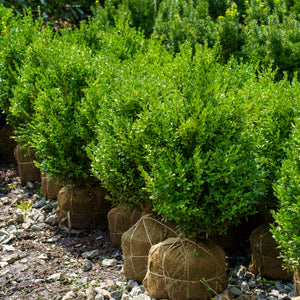Green Mountain Boxwood: Upright Evergreen Structure with Year-Round Polish
Welcome to this week’s “Plant of the Week.” For dependable, formal structure in landscapes, Green Mountain Boxwood (Buxus × ‘Green Mountain’) is a standout. This cold-hardy, broadleaf evergreen carries a natural upright, pyramidal habit that holds its shape with minimal pruning, offering four-season color, clean lines, and long service life in foundation beds, borders, and formal designs.


What Makes Green Mountain Boxwood Special?
Green Mountain Boxwood distinguishes itself with a naturally upright, pyramidal habit and dense, fine-textured foliage that reads crisp and architectural year-round. It lends beds and entries a “freshly clipped” look even with modest maintenance, and the glossy, rich-green leaves keep their color through the seasons. In exposed winter sites the foliage may bronze lightly, but plants rebound quickly with the spring flush.
Maturing slowly to about 5 to 7 feet tall and 2.5 to 4 feet wide, ‘Green Mountain’ supplies vertical emphasis without overwhelming nearby plantings or hardscapes. Its tight branching creates a solid green framework that holds clean lines through wind, rain, and snow. Unlike rounded boxwoods that demand frequent shaping to stay formal, this cultivar naturally maintains its cone, yet it also responds beautifully to shearing for sharper geometry, low screens, or light topiary—equally at home in classic parterres and contemporary foundations.
Hardy in USDA Zones 4 to 8, ‘Green Mountain’ is reliably cold-tolerant for New Jersey and thrives in full sun to partial shade. It performs best in well-drained loam with a neutral to slightly alkaline pH, and once established it’s steady and low-maintenance, with good deer resistance. Durable enough for front-of-house placements, containers, and high-visibility hedging, it delivers year-round polish with minimal fuss.

How to Use Green Mountain Boxwood in the Garden
Entry Architecture & Sightlines
Use a matched pair to frame a front door, gate, or walk where vertical lines convey order and guide the eye. In tight setbacks, the narrow footprint keeps traffic clear while delivering presence. For multi-story houses, stagger three in a 1-2 stepped grouping to scale the vertical plane without crowding windows.
Formal Hedges & Garden Rooms
‘Green Mountain’ knits into incredibly clean hedges. For a solid wall, space 2.5 to 3 feet on center; for a looser, rhythmic line that reads as individuals with slight separation, space 3 to 4 feet. The natural cone means the hedge can be slightly tapered (wider at the base) to keep light on lower foliage and prevent thinning.
Foundation Backbone
Treat it as a structural backbone that carries the composition between peak seasons. Pair with spring azaleas and rhododendrons (color early), panicle hydrangeas (summer drama), and fall asters or sedums (autumn finish). The evergreen mass provides continuity while the seasonal players rotate.
Parterres, Knots & Punctuation
In formal layouts, deploy it at corners of parterres, the ends of hedged runs, or as periodic punctuation posts every 6–8 feet to keep geometry crisp. Combine with low edging (dwarf boxwood, inkberry, or euonymus) for layered height and texture.
Containers & Hardscape Softening
In large, frost-proof containers (18–24+ inch diameter with drainage), ‘Green Mountain’ gives year-round structure on terraces and stoops. Its upright cone reads clearly at distance, stays tidy in winter, and can be underplanted seasonally with pansies, hellebores, or trailing ivy for turnover color.

How to Care for Green Mountain Boxwood
Site & Soil Prep
Choose full sun to part shade; in NJ, morning sun with light afternoon shade helps curb winter bronzing. Aim for drained, airy soil—amend heavy clay with compost + pine bark fines to improve structure. Target pH 6.8–7.4; if soil skews acidic, a modest lime application can move pH toward neutral (always soil-test first).
Planting
Dig a hole 2× as wide as the root ball and no deeper than the root flare. Backfill with native soil improved (not replaced) by up to 30% compost. Set the plant slightly high (½–1 inch above grade) to avoid water pooling at the crown. Water to settle; apply a 2–3 inch mulch ring, keeping mulch 3 inches off stems.
Watering
For the first season, water 1–2 times weekly, delivering 1–1.5 inches per week (including rainfall). In summer drought, switch to deep, infrequent soaks. Once established, it’s moderately drought-tolerant, but will look best with consistent moisture - not saturation.
Feeding
Boxwood is a light feeder. In early spring, top-dress with compost or apply a balanced, slow-release fertilizer at label rates. Avoid heavy nitrogen, which pushes soft growth more prone to winter scorch and pests.
Pruning & Shearing
Time your main shaping after the spring flush (late May–June). Keep the hedge slightly wider at the base for light penetration. If a second tune-up is needed, late August is the latest you should clip—this allows new foliage to harden before frost. For renovation (reducing height/width more than 20–30%), stage the cutback over two seasons to avoid shock.
Winter Care
Water thoroughly before ground freeze to reduce desiccation. In exposed, windy sites, consider burlap wind screens or an anti-desiccant spray (apply above 40°F on dry days). Brush off wet, heavy snow promptly to prevent splaying; don’t beat or bend branches.
Spacing & Airflow
Good airflow is your friend. Maintain 2.5–3 ft on center for hedges and 3+ ft of breathing room for specimens near walls or corners. Avoid packing mulch into the interior canopy—stale humidity encourages disease.
Pests & Disease (Integrated Practices)
- Boxwood Leafminer: Look for blistered leaves in spring. Favor selective pruning of infested tips; consider timing any systemic or bio-based controls per local guidance if pressure is high.
- Boxwood Psyllid: Causes cupped leaves on spring flush; largely cosmetic. Prune out worst tips; natural predators often keep it in check.
- Boxwood Blight / Volutella: Prioritize clean stock, tool sanitation (70% alcohol or 10% bleach), and airflow. Avoid overhead irrigation. Immediately remove and discard infected debris—do not compost.
- Physiological Winter Burn: Usually cosmetic; foliage generally greens up with spring growth. Improve site, mulch, and pre-freeze irrigation to reduce recurrence.
CONCLUSION
Green Mountain Boxwood (Buxus x ‘Green Mountain’) delivers the rare combination of built-in geometry, four-season color, and cooperative growth that designers rely on for high-visibility spaces. Its natural cone solves for vertical emphasis where space is tight, its moderate size slots into foundations and hedges without overpowering, and its durability carries New Jersey landscapes through winter with grace. If your goal is year-round polish with modest upkeep, ‘Green Mountain’ is a proven, professional-grade solution.







